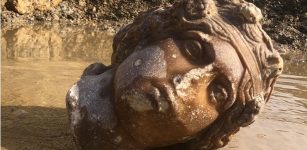Small House With Beautiful Mythical Frescoes Discovered In Pompeii
Jan Bartek - AncientPages.com - Archaeologists have recently uncovered a small house in Pompeii, providing valuable insights into the distinctive decorative styles of Roman residences. This discovery occurred during a construction project within the Pompeii Archaeological Park, specifically in the Insula dei Casti Amanti, or House of Chaste Lovers, as reported by park authorities.
The house's relatively small size in comparison to the surrounding buildings presents an intriguing contrast, especially considering its lavish interior artwork.
Credit: Parco Archeologico di Pompei
The frescoes predominantly illustrate scenes from classical Greek mythology. A well-preserved depiction of Hippolytus and Phaedra—characters from Greek tragedy—has led to the provisional naming of this dwelling as the House of Phaedra. These figures also appear in another smaller painting within the residence.
In addition to these portrayals, archaeologists identified a fresco featuring a satyr—a mythological figure part man and part goat—embracing a nymph, alongside another depicting deities believed to be Venus and Adonis. Another fresco possibly represents the Judgement of Paris; however, it is challenging to interpret due to damage.
Credit: Parco Archeologico di Pompei
In the courtyard area, further artwork was discovered primarily illustrating flora and fauna, including a bird of prey and two snakes positioned opposite each other around an altar where offerings were traditionally placed; remnants from such offerings prior to Mount Vesuvius's eruption remain intact. Among these findings are a ceramic incense burner, a lamp with traces of scented essences, colored marble fragments, and a sculpture representing Dionysus at this altar site.
Credit: Parco Archeologico di Pompei
Credit: Parco Archeologico di Pompei
“We have archaeologists, restorers, archaeobotanists here to understand exactly how the ritual of the last sacrifice was carried out before the eruption. There are still the burnt remains of this ritual, there is the knife that was used,” Gabriel Zuchtriegel, the park’s director said in a press statement.
Credit: Parco Archeologico di Pompei
Park officials have indicated that these discoveries at this ancient home may shed light on societal transformations within Roman culture during the first century CE—particularly in Pompeii—as evidenced by its architectural distinctions from neighboring homes. A scholarly article examining this house's unique layout has been published in the archaeological park’s digital magazine dedicated to Pompeian studies.
See also: More Archaeology News
In AD 79, Pompeii experienced a catastrophic event when Mount Vesuvius erupted, covering the city and its thousands of residents under layers of ash and pumice. Despite this devastation, archaeological excavations have provided researchers with valuable insights into daily life in Pompeii prior to the disaster. These findings offer a detailed glimpse into the social, economic, and cultural aspects of the ancient city.
Written by Jan Bartek - AncientPages.com Staff Writer

























